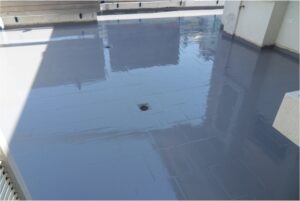
HOW TO WATERPROOF A BALCONY WITHOUT REMOVING THE EXISTING FLOOR
These days, the need to remove the existing floor on a balcony even if damaged, is solved by
advanced innovation in new waterproofing technology
By far the best solution is to use eco-friendly, water-based liquid waterproofing products that are resistant to U.V. and thermal
shocks plus can preserve structures from the agression of water and atmospheric agents.

Balconies and terraces are the main places in the house where atmospheric agents can cause
decay, with the result that over a period of time this could involve a large part of the structure.
Among the main causes of decay is the affect from water – especially acid rain – and the
presence in the air of polluting elements, such as carbon dioxide, which when reacting with
lime causes carbonation corroding of the concrete.
This combined with freezing conditions and frost cycles especially on paved balconies, can
cause tiles to debond and generate cracks. This can also damage the reinforcement which if
unprotected, can get covered by rust, weakening the structure and causing even more long
term damage.
The waterproofing of balconies and terraces is one of the most requested solutions in
renovation works, a market that in 2021 reached almost 75% of the entire value in the
construction sector. The possibility of creating an effective barrier to water and humidity
infiltrations without having to remove the existing flooring means not only saving time and
money, but also following the principles of sustainable construction, avoiding to overload
landfill with polluting inert materials.
What is really important in waterproofing solutions in general, and on terraces and balconies
in particular, is the preparation of the substrate. In fact, the full success of the work will
depend on this phase. Before starting this work, not only the flooring but also the wall lining
must be inspected and repaired if required. A correct maintenance and preparation of the
substrate, especially when working on an existing flooring must be done using guaranteed
products and systems in line with the building regulations.
This is now possible using single-component pastes that are extremely effective to prepare the
substrate and restore the correct slopes, and using specific mortars designed to deal with
damp surfaces subject to extreme temperature changes.
In addition, in order to allow the wall base to form an effective protective barrier, it is
recommended to use pre-mixed waterproofing products, applied on both polymer-bitumen
membranes and liquid waterproofing products.
Water and humidity are not the only factors that generally compromise the structural strength
of balconies: the damage caused from constant ultraviolet rays and, more generally, the
climatic changes that lead to freezing and thawing cycles can start the stagnation of water
which over time has a dangerous corrosive action.
The answer to this comes again from modern technology: the innovation of modern
waterproofing systems that protect for a long time, even in the most severe external
conditions.
The best results are obtained just using liquid waterproofing products which, being extremely
easy to use can reach any affected area without any difficulty.


There are water-based formulations (without solvents that pollute or are harmful to health),
additives with modified resins and synthetic fibers that offer an excellent resistance to water
stagnation and to the aging caused by U.V. rays.
These products which can also be used at temperatures from 0 to 45 degrees, on substrates
that have permanent problems of humidity or even wet, and can be applied to any type of
substrate: concrete, ceramic, marble, brick, existing bituminous membranes, etc.
Modern technology offers extremely high performing single-product and systemic solutions,
so inventive that they not just give perfect waterproofing, but they also carry out a protective
solution on the treated substrates. In particular, low viscosity transparent protective
waterproofing products are applied directly on the finished layer, leaving the visible face of the
tiles unaltered. Invisible and effective and above all, a long-lasting waterproofing solution.












